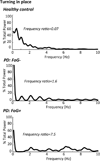Objective biomarkers of balance and gait for Parkinson's disease using body-worn sensors
- PMID: 24132842
- PMCID: PMC3927718
- DOI: 10.1002/mds.25684
Objective biomarkers of balance and gait for Parkinson's disease using body-worn sensors
Abstract
Balance and gait impairments characterize the progression of Parkinson's disease (PD), predict the risk of falling, and are important contributors to reduced quality of life. Advances in technology of small, body-worn, inertial sensors have made it possible to develop quick, objective measures of balance and gait impairments in the clinic for research trials and clinical practice. Objective balance and gait metrics may eventually provide useful biomarkers for PD. In fact, objective balance and gait measures are already being used as surrogate endpoints for demonstrating clinical efficacy of new treatments, in place of counting falls from diaries, using stop-watch measures of gait speed, or clinical balance rating scales. This review summarizes the types of objective measures available from body-worn sensors. The metrics are organized based on the neural control system for mobility affected by PD: postural stability in stance, postural responses, gait initiation, gait (temporal-spatial lower and upper body coordination and dynamic equilibrium), postural transitions, and freezing of gait. However, the explosion of metrics derived by wearable sensors during prescribed balance and gait tasks, which are abnormal in individuals with PD, do not yet qualify as behavioral biomarkers, because many balance and gait impairments observed in PD are not specific to the disease, nor have they been related to specific pathophysiologic biomarkers. In the future, the most useful balance and gait biomarkers for PD will be those that are sensitive and specific for early PD and are related to the underlying disease process.
Keywords: balance; clinical trials; gait; technology.
© 2013 Movement Disorder Society.
Figures





References
-
- Biomarkers and surrogate endpoints: preferred definitions and conceptual framework. Clin Pharmacol Ther. 2001;69(3):89–95. - PubMed
-
- MacPherson JMHF. Posture. Chapter 41. In: Kandel ERSJ, Jessell TM, Siegelbaum SA, Hudspeth AJ, editors. Principles of Neural Science. Fifth edition. New York, NY: McGraw-Hill; 2012.
-
- Winter D. Biomechanics and Motor Control of Human Movement. Fourth Edition ed. Hoboken, New Jersey: John Wiley & Sons, Inc; 2009.
-
- Nutt JG, Horak FB, Bloem BR. Milestones in gait, balance, and falling. Mov Disord. 2011;26(6):1166–1174. - PubMed
Publication types
MeSH terms
Substances
Grants and funding
LinkOut - more resources
Full Text Sources
Other Literature Sources
Medical

